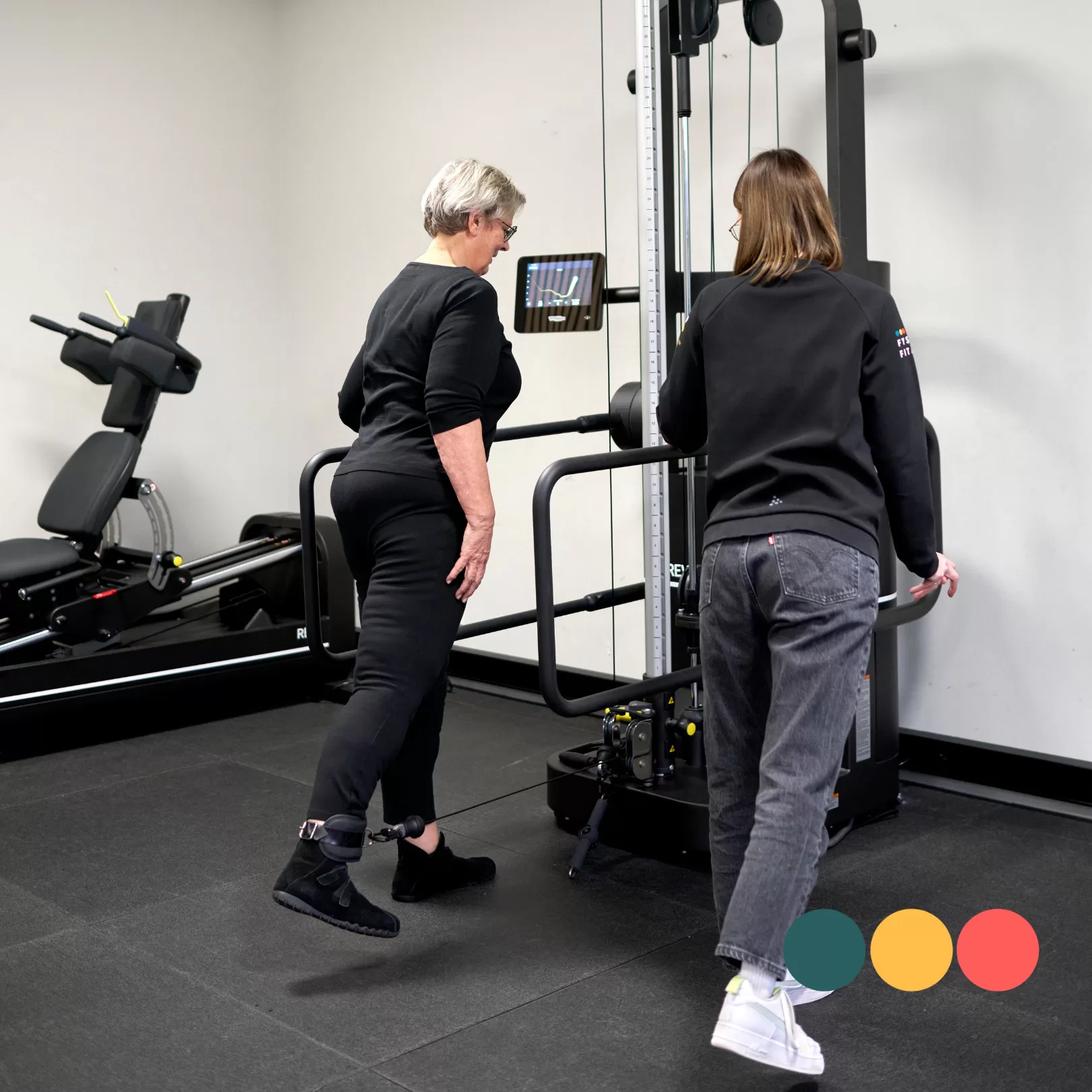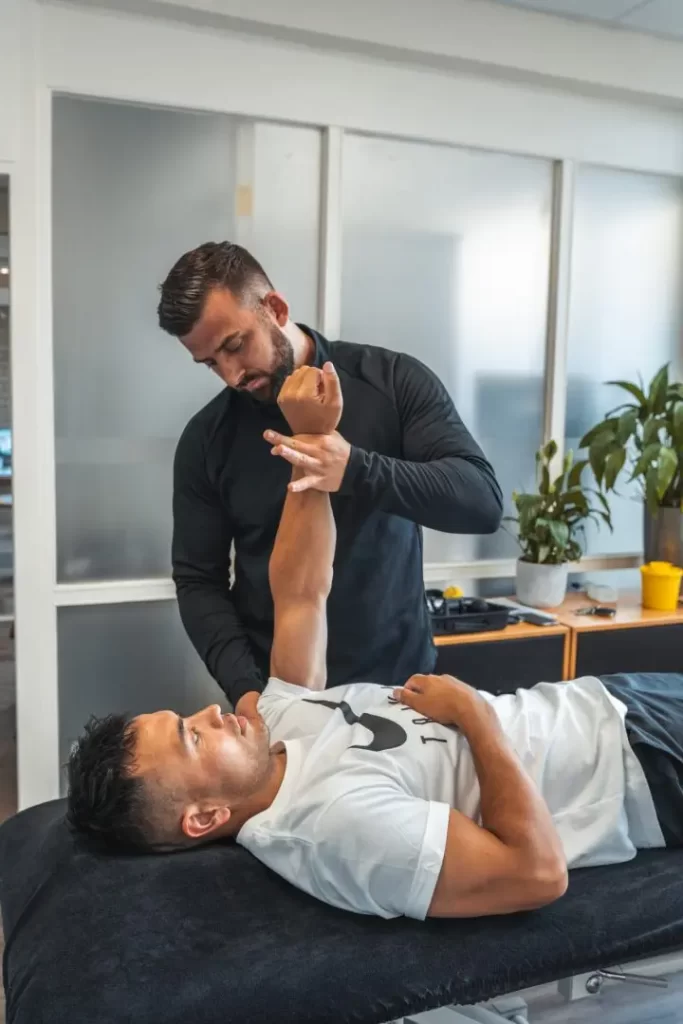Physiotherapy after hip replacement

Rehabilitating with a new hip
When various treatments no longer have the desired effect, a total hip replacement is an option. The joint is often replaced in its entirety with a prosthesis. The muscle strength and mobility of the joint is often reduced due to osteoarthritis and surgery. A quick start to rehabilitation is very important for the recovery of these functions. The therapists at Fysio Fitaal will teach you how to strengthen the muscles around the hip and how to regain mobility in the joint. They also look at how best to carry out your daily activities. Most people can walk again without crutches after 6 weeks. After that, the pain in the hip will continue to decrease. Fitness gradually increases again and walking will become increasingly easier. On average, rehabilitation from new knee or hip takes 3-9 months.
A hip replacement aims to:
- Reduce pain
- Improve quality of life
- Increasing hip mobility
- Being able to walk normally
The lifespan of a hip replacement
When the symptoms only increase and you are too restricted in your daily life, a hip replacement may be a solution. These complaints in the hip are often the result of osteoarthritis. With a new hip, you will regain more freedom of movement and the symptoms will decrease. An artificial hip normally lasts at least 15 years. How long it will eventually last depends on several factors:
- the physical condition
- body weight
- activity level of the person
If you put too much strain on the artificial hip, the prosthesis may not last as long. Thanks to these surgical techniques, many people have regained a better and more active life. In more than 90% of all cases, recognisable pain is no longer present after surgery. The hip prosthesis is designed to mimic the function and anatomy of the hip as closely as possible.
The operation
There is usually a choice between general anaesthesia or regional anaesthesia using an epidural. The operation takes about 1.5 hours. First, the original hip socket is cleaned and damaged structures are removed. Then a plastic socket is inserted into the socket of the hip. As a replacement for the hip socket, a metal pin is inserted into the thigh to which the new socket is attached. Thus, the joint is replaced in its entirety, both the socket and the head of the hip. After insertion, the surgeon will test the mobility of the hip. antibiotics will be given before the operation to minimise the risk of bacterial infection. After surgery, you stay for a while to check that everything is going well. In most cases, you will be allowed to go home the same day or the morning after.
Overall physical condition
A pre-operative exercise programme can help you avoid complications. This follows the BiBo concept. Better in, Better out. The fitter you go into surgery, the faster your recovery, the less risk of complications. Smoking has a negative impact on blood flow and the quality of connective tissue. It can therefore adversely affect wound healing but also further recovery. If you are overweight, it is advisable to lose some weight to minimise unnecessary stress on the hip after surgery.
Tips for immediately after surgery
- Keep moving. See if you can already manage to take a short walk with the crutches every hour for 3-10 minutes.
- Put the leg up high to allow the swelling to go down.
- Do not sit with the leg down for too long. This can cause a lot of pressure in the hip.
- Practice bending stretching the hip a lot. Being able to bend quickly to 90 degrees is necessary for further therapy on, for example, an exercise bike.
- You may just take support on the leg with the help of your crutches. Do not be afraid to strain. Unless otherwise directed by the hospital.
- The hip may be reactive for an extended period of time. This means that a reaction to strain is normal. An example is temporarily more symptoms because you did a bit more in the morning, for example. Get well again!
- For the first 6 weeks, it is not usual to drive a car. The wound is still recovering and may reopen with a quick unexpected movement. Also, it is not convenient insurance-wise should you cause damage to yourself or others.
- In case of fever, redness or irritation of the wound, call the hospital to be sure.
- Redness and shiny calf along with cramping can be a sign of thrombosis. Keep a close eye on this.
- With the dentist, always indicate that you have a joint prosthesis. This is because of the increased risk of infection.
The first phase
In the first 6 weeks, the prosthesis should start to grow in. High-speed movements should be avoided. The scar may remain somewhat sensitive for the next few weeks to months. A blue discolouration of the leg, swelling and pain may be present. Pain relief is therefore recommended. Because you move less along with the side effects of surgery, you will be given medication to prevent thrombosis.
The next steps
Successful rehabilitation consists of several stages and steps. Good strength, stability and control of the hip are necessary to safely perform your daily activities again. During rehabilitation, you will visit the physiotherapist on average 2-3 times a week. The first phase of rehabilitation will focus on restoring hip mobility and walking pattern. After that, the focus will be on the strength of the muscles around the hip. How long the rehabilitation will take often depends on several factors and therefore cannot be said well in advance. However, guidelines are available on the goals to be achieved:
- Within 4 weeks with 1 crutch
- Within six weeks without crutches
- Driving again after 6 weeks
- Cycling outside again after 4 months
Physio Vital & Vive Living
With Vief Life we want to provide people with symptoms of osteoarthritis with strength and knowledge to regain control of their own health and freedom in life.
We focus entirely on the treatment of knee and hip osteoarthritis in Tilburg along with rehabilitation after knee or hip replacement surgery. Vive life believes in a better approach in Physiotherapy treatment of osteoarthritis-related complaints. With our unique method, we aim to provide people with strength and knowledge to regain control of your situation this way.
View here vief life's website.
A hip replacement rehabilitation takes 6-9 months on average. During rehabilitation, small and sometimes big setbacks will always come your way. Especially in certain phases, it will be slower than you had thought beforehand. Patience is necessary. Our specialists will guide and motivate you as much as possible during this process. Fysio Fitaal works with specialists in the field of rehabilitation after surgery and osteoarthritis-related complaints. This combination of expertise, extensive facilities and passion for physiotherapy puts you in the right place.
Frequently asked questions
How can I relieve the pain of hip osteoarthritis?
Pain relief for hip osteoarthritis can be achieved using painkillers, corticosteroid injections, heat or cold treatments and physiotherapy.
How is hip osteoarthritis diagnosed?
Hip osteoarthritis is usually diagnosed through X-rays, CT scans or MRIs, as well as an assessment of symptoms and medical history by a doctor/orthopedist.
Can hip osteoarthritis be prevented?
Although hip osteoarthritis cannot be completely prevented, healthy lifestyle choices such as weight management, regular exercise and avoiding excessive stress on the hips can help reduce the risk.
When is a hip replacement needed for hip osteoarthritis?
A hip replacement (THP) is usually considered when the pain and limitations due to hip osteoarthritis are severe and do not respond to conservative treatments.
What is hip osteoarthritis?
Hip osteoarthritis is a condition in which the cartilage in the hip joint gradually deteriorates, leading to pain, stiffness and reduced mobility in the hip.
What causes hip osteoarthritis?
Hip osteoarthritis can be caused by ageing, excessive wear and tear, genetic factors, injury to the hip and excessive strain.
What are the treatment options for hip osteoarthritis?
Treatment options for hip osteoarthritis include medication, physiotherapy, lifestyle modifications, weight management, injections, and in some cases, hip replacement (THP) surgery.
What are the symptoms of hip osteoarthritis?
Symptoms of hip osteoarthritis include pain in the hip, stiffness, reduced range of motion, swelling and possibly crepitus (grinding sounds) in the joint.
Making an appointment at FysioFitaal
We work from multiple locations in Tilburg, always close by for professional and accessible physiotherapy. Fill in the contact form and we will contact you soon. Together, we will work on your recovery!

